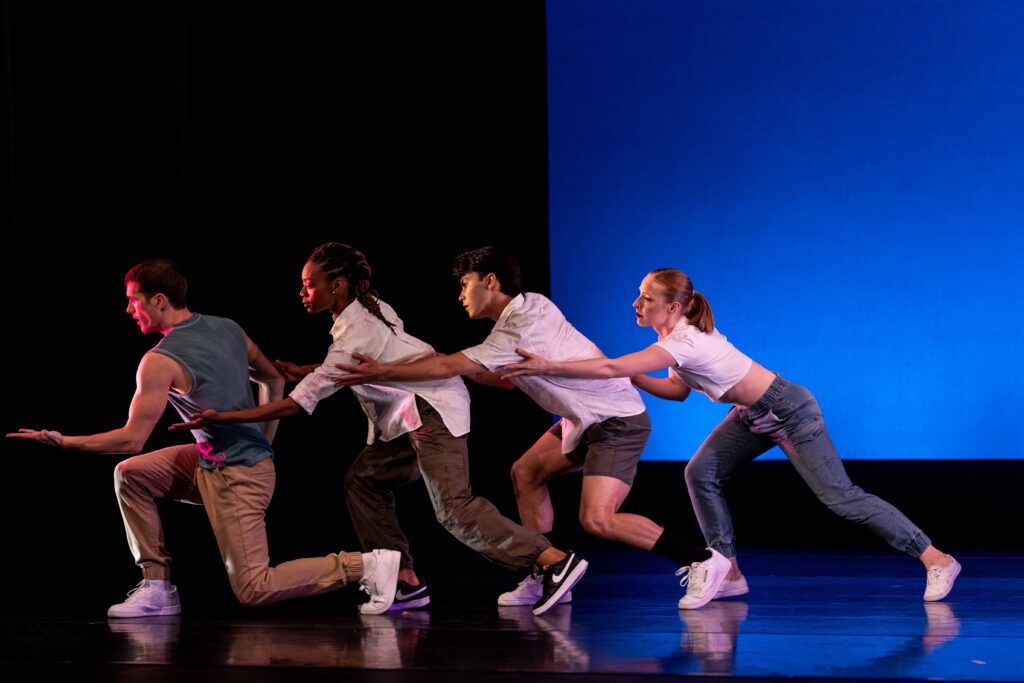Chamber Dance Project’s ‘Slam!’ Festival
By • June 29, 2023 0 1444

On June 22-25, Diane Coburn Bruning’s Chamber Dance Project presented “Slam! A Festival of Ballets” at American University’s 300-seat Greenberg Theatre on Wisconsin Avenue in Tenleytown.
In the corridor, 10 mannequins wore snazzy outfits designed for the company over its decade in the nation’s capital. On the bare stage, the opening-night program offered five compelling works of dance — costumed by Holly Hynes, Monica Leland and Bekah Nettekoven Tello and lit by Maja E. White — and two of music.
One of the musical selections was a virtuosic solo — the fourth movement of Paul Hindemith’s opus 31, number 2, violin sonata of 1924 — played by Sally McLain, principal musician of Chamber Dance Project. The other was a quartet arrangement of Astor Piazzolla’s “Libertango” of 1974, performed by McLain, violinist Karen Kelleher, violist Jerome Gordon and cellist Steve Honigberg.
Live accompaniment is an essential element of Chamber Dance Project’s identity; four of the five dance pieces were set to music adeptly performed by the quartet, a treat in itself.
First up was “Alight,” set two years ago to Chris Rogerson’s String Quartet No. 1 of 2009 by Atlanta Ballet choreographer-in-residence Claudia Schreier — like the composer a 30-something rising star. Danced by three men in light green tops and dark green tights and two women in backless green tops and black tights, the screen behind them lit in bright blue, the choreography seemed perfectly matched to the music: modernized classical in style, always with a sense of surprise.

Left to right: Poet Gayle Danley, dancer Sophie Miklosovic and dancer John-Paul Simoens perform in “Slam!” Photo by David Moss. Courtesy Chamber Dance Project.
After “Libertango” came two excerpts from Bruning’s 2014 work “Time Has Come.” A boldly executed solo by Sophie Miklosovic was followed by a pas de deux danced by Fuki Takahashi and Patric Palkens. Takahashi’s character toyed with Palkens’s, rudely pushing him and eventually walking (literally) on his back. The facial expressions and cheery music, by Baroque composer Georg Philipp Telemann, signaled it was all for comic effect.
Closing out the first half was the premiere of Bruning’s “Weave the Wind,” set to four of the five movements, slightly rearranged — The Ellipse, The Orangery, The Herbaceous Border and The Beech Tree — of “Plan & Elevation,” a Dumbarton Oaks commission from composer Caroline Shaw for the 75th anniversary, in 2015, of Georgetown’s Harvard-owned humanities center.
Like the ravishing music, the choreography presented four distinct, contrasting pictures. Hannah Bruce, Takahashi and Miklosovic danced the first section, synched to the quartet, which began halfway through to play pizzicato, suggesting rain. In the all-male second section, John-Paul Simoens, Alexander Sargent and Ian Debono moved with graceful athleticism to rapid arpeggios. The third section, a slow pas de deux by Takahashi and Palkens — their characters on better terms than in “Time Has Come” — featured an extended partnered spin. (Commented Bruning: “It’s tough for him because he has to stop her and still remain upright.”) All six dancers shared the stage in the stately concluding section.
After intermission, Debono and Simoens performed “Exit Wounds” of 2014, choreographed by Bruning to music from prolific minimalist Philip Glass’s String Quartets No. 3, 5 and 2. This moving work, in which the dancers interact as brothers, friends and lovers, shifting roles from moment to moment, ends with one rocking the other in his lap (fade to black).
And now for something completely different. The program’s finale was the premiere of the festival’s title work, conceived and directed by Bruning. A fusion of spoken word and contemporary ballet, unaccompanied by music, “SLAM!” has a text in four movements written by poets and teaching artists Drew Anderson and Gayle Danley for their own live performance.
Alternating call-and-response duets with solo raps, Anderson’s and Danley’s masterful, audience-grabbing recitations focused on workplaces: the classroom, a restaurant, a hospital. Their unfolding narratives were illustrated by the dancers’ bodies, the work’s four sections choreographed by, respectively: Gabrielle Lamb, artistic director of New York-based Pigeonwing Dance; Peter Chu, whose Las Vegas-based company is called chuthis.; Andile Ndlovu of the Washington Ballet; and Victor Adebusola, a faculty member at Metropolitan School of the Arts in Alexandria.
“I chose four choreographers whose work has interested me and who I felt could deal in interesting ways with the slam poetry,” explained Bruning, who met with Anderson and Danley to refine the script, then shared it with the choreographers, who were asked to pick their first- and second-choice sections to set. “Miraculously,” she said, “they all chose a different section.”
Founded by Bruning in New York in 2000, Chamber Dance Project is naturally a showcase for her consummate, often innovative, choreography. But the word “project” in the company’s name is apt; it has become a remarkable platform for the nurturing of contemporary ballet.
Chamber Dance Project was designed to give opportunities to young dancers during the breaks in their regular performance seasons. The eight who appeared included members of Atlanta Ballet (Palkens and Takahashi), BalletMet of Columbus, Ohio (Miklosovic), San Francisco Ballet (Simoens) and Seattle’s Spectrum Dance Theater (Jiamond Watson, a Duke Ellington School of the Arts alumna), along with recent graduates of Juilliard (Sargent) and Pittsburgh’s Point Pleasant University (Bruce) and a Juilliard student (Debono).
As she remarked during the intermission, having choreographed for years for dance, theater and opera companies, after Bruning’s sons were born, she told herself, “There’s gotta be more.” While “Slam!” is the most audacious example of her commitment to collaboration, it is in no sense an outlier. Bruning’s credo as Chamber Dance Project’s artistic director — bringing together dancers, choreographers, musicians and, lately, poets — is, she says: “Here’s an idea. Go.”

